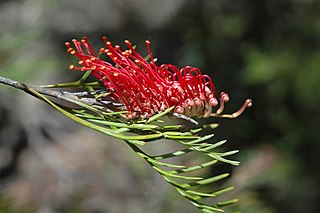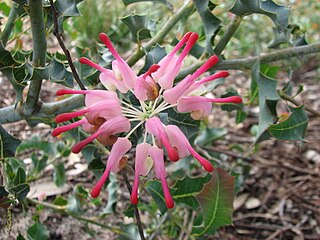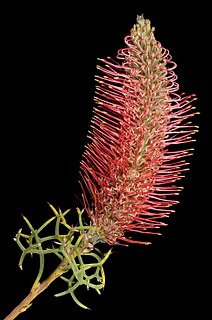
Grevillea petrophiloides, commonly known as pink pokers, rock grevillea or poker grevillea, is a species of flowering plant in the family Proteaceae and is endemic to the south-west of Western Australia. It is an erect shrub with divided leaves, the lobes mostly linear, and cylindrical clusters of usually pink to reddish pink and bluish-grey flowers.

Grevillea fililoba is a species of flowering plant in the family Proteaceae and is endemic to a restricted area in the south-west of Western Australia. It is a spreading shrub with soft foliage, divided leaves with narrow linear lobes, and clusters of pink to bright red and white flowers.

Grevillea pilosa is a species of flowering plant in the family Proteaceae and is endemic to the south-west of Western Australia. It is a spreading to prostrate shrub with wedge-shaped to oblong leaves with sharply pointed, more or less triangular teeth or lobes, and clusters of pale pink to rose-pink or red flowers.

Grevillea manglesii is a species of flowering plant in the family Proteaceae and is endemic to an area around Perth in Western Australia. It is a spreading shrub with divided leaves, with triangular or linear lobes, and clusters of cream-coloured or white flowers.

Grevillea concinna, commonly known as red combs or elegant grevillea, is a species of flowering plant in the family Proteaceae and is endemic to the south-west of Western Australia. It is a spreading to erect shrub with mostly linear to narrow wedge-shaped leaves sometimes with a sharp point on the tip. Flower colour varies with subspecies.

Grevillea hookeriana, commonly known as red toothbrushes or Hooker's grevillea, is a species of flowering plant in the family Proteaceae and is endemic to the south-west of Western Australia. It is a spreading to erect shrub, usually with linear leaves or deeply divided leaves with linear lobes, and toothbrush-shaped groups of red, black or yellowish green flowers, the style maroon to black.

Grevillea diversifolia, the variable-leaved grevillea, is a species of flowering plant in the family Proteaceae and is endemic to the south-west of Western Australia. It is an erect to prostrate shrub with simple or divided leaves and groups white to cream-coloured flowers with a dull red style.

Grevillea plurijuga is a species of flowering plant in the family Proteaceae and is endemic to southern Western Australia. It is a prostrate to low-lying or dense mounded to erect shrub with divided leaves with linear lobes and loose clusters of hairy, red or pink flowers.

Grevillea dryandroides, commonly known as phalanx grevillea, is a species of flowering plant in the family Proteaceae and is endemic to the south-west of Western Australia. A diffuse, clumping shrub, it often forms suckers and has divided leaves with up to 35 pairs of leaflets, and groups of red to pinkish flowers on an unusually long, trailing peduncle.

Grevillea nana, commonly known as dwarf grevillea, is a species of flowering plant in the family Proteaceae and is endemic to the south-west of Western Australia. It is a prostrate to low, mounded, dense shrub with divided leaves with sharply-pointed, linear lobes, and clusters of pink, ornage, yellow or red flowers.

Grevillea insignis, commonly known as wax grevillea, is a species of flowering plant in the family Proteaceae and is endemic to the south-west of Western Australia. It is an erect, bushy shrub with more or less oblong leaves with seven to seventeen sharply-pointed, triangular teeth, and more or less spherical or cylindrical clusters of cream-coloured flowers ageing to pink.
Grevillea nematophylla, commonly known as water bush or silver-leaved water bush, is a species of flowering plant in the family Proteaceae and is endemic to Australia. It is shrub or small tree with simple or pinnatisect leaves, the leaves or lobes linear, and branched, cylindrical clusters of cream-coloured flowers.

Eremophila densifolia is a flowering plant in the figwort family, Scrophulariaceae and is endemic to the south-west of Western Australia. It is usually a low, spreading shrub with densely clustered leaves and lilac to purple flowers.

Grevillea commutata is a species of flowering plant in the family Proteaceae and is endemic to the west of Western Australia. It is a spreading, open to dense shrub with egg-shaped leaves with the narrower end towards the base, and white, cream-coloured, and pinkish-green flowers.

Grevillea fulgens is a species of flowering plant in the family Proteaceae and is endemic to an area near Ravensthorpe in the south-west of Western Australia. It is a spreading to straggling shrub with simple or pinnatifid leaves, and deep pink or reddish flowers.

Grevillea manglesioides is a species of flowering plant in the family Proteaceae and is endemic to the south-west of Western Australia. It is a spreading shrub usually with wedge-shaped leaves with lobed ends, and toothbrush-shaped clusters of flowers, the colour varying with subspecies.

Grevillea obliquistigma is a species of flowering plant in the family Proteaceae and is endemic to the south-west of Western Australia. It is a spreading shrub with linear leaves, and conical to cylindrical clusters of creamy-white to yellowish cream-coloured flowers, sometimes tinged with pink.

Grevillea paradoxa, commonly known as the bottlebrush grevillea, is a species of flowering plant in the family Proteaceae and is endemic to the south-west of Western Australia. It is an erect to spreading, prickly shrub with pinnatipartite leaves, the lobes linear, widely spreading and sharply pointed, and with cylindrical clusters of pale to dark pink or cream-coloured flowers with a pinkish-red style.

Grevillea neorigida is a species of flowering plant in the family Proteaceae and is endemic to Western Australia. It is compact, spreading shrub with deeply-divided leaves, the end lobes linear and somewhat sharply-pointed, and clusters of creamy-brown to off-white flowers with a scarlet or orange-red style.

Lasiopetalum glutinosum is a species of flowering plant in the family Malvaceae and is endemic to the south-west of Western Australia. It is a spreading, multi-stemmed shrub with densely hairy young stems, egg-shaped leaves often with three lobes and bright pink or dark red flowers.



















